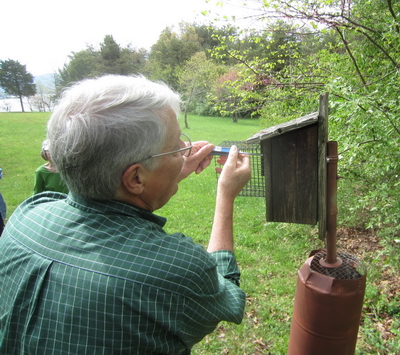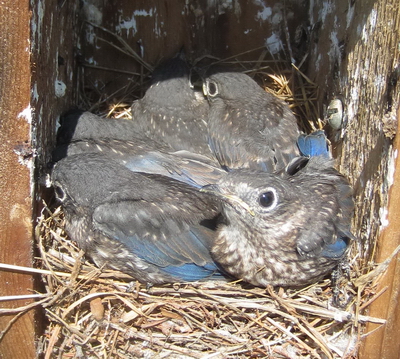Blue Bird Nest Monitoring - A New Adventure
by Jim Gerhart, Friends of Smith Mountain Lake State Park
 |
Team Leader, Dick Hendrix, demonstrating the proper protocol for opening a blue bird nesting box. |
Having been with the Friends of Smith Mountain Lake State Park since it was incorporated 19 years ago, my wife, Patti and I thought we would try something new to us, blue bird nesting box monitoring. About 15 years ago, the Friends built and the park staff installed 14 blue bird nesting boxes which were strategically located throughout the park. We thought that if you build it, they will come. They came but not always blue birds.
Two years ago the Friends teamed up with members of the Master Naturalists, Blue Ridge, Foothills and Lakes chapter. The old blue bird boxes were refurbished and predator guards were installed. Dick Hendrix, a member of both organizations organized volunteers this spring to begin monitoring blue bird nesting box activity. The job turned out to be just what Patti and I were looking for. We are learning, not only about blue bird cycles, but ways to increase their chances of successfully raising a brood. Our most important tools are a putty knife and a bar of unscented soap.
As we check the boxes along our blue bird box trail, we have found that our most frequent visitors are wasps. They attach their nests to the inside roof of the box which deters blue birds from entering. Fortunately the wasps do not like soap, so we remove the wasp’s nest with a putty knife and rub unscented soap inside the roof edges which discourages their return.
Sometimes we encounter nests not consistent with blue birds. We try to identify them with the information packets we carry with us. If it is a desirable bird, we leave the nest alone. But if it is a sparrow, we will remove it if there are no chicks in the nest.
There is a regular protocol for inspection: knock before opening the door; check for blowflies or ant infestations; keep track of the age of the eggs; try to account for all egg hatches; estimate the age of the young; note when they fledge; keep detailed notes to pass on to the next team scheduled to check the boxes.
Once the brood has fledged, we remove the nest, otherwise the blue bird will build another nest on top of the old one. This puts them in closer reach of the woodpecker. If we are fortunate, the blue birds will have three broods during the summer.
We like what we are doing because it is largely through conservation efforts that the blue bird is making a comeback. The population has declined by as much as 90% because of the loss of natural cavities for nesting. Wood fence posts were replaced with metal posts and dead trees and limbs were cut for firewood. Also, in the 1800’s, man brought the starling and sparrow from Europe. These birds are so adaptable and aggressive that they spread across the continent taking nesting sites and even killing native birds and destroying their eggs. Everyone can help by installing a nesting box in their own yard, monitor the box and identify and correct nesting problems to help improve the blue bird’s chance of survival.
 |
Six blue birds ready to fledge.
|

